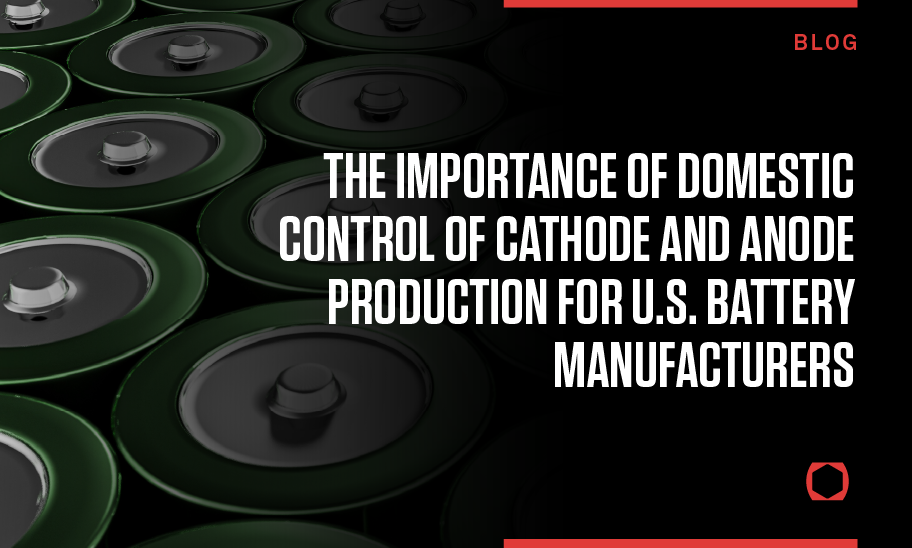
The Importance of Domestic Control of Cathode and Anode Production for U.S. Battery Manufacturers
The rising demand for efficient, high-performing batteries is transforming the energy landscape. As the U.S. battery manufacturing industry grows, developing a domestic supply of cathode and anode active materials has become critical. These components are essential for lithium-ion batteries used in electric vehicles, energy storage, and other advanced technology. But why is it so important for the U.S. to control its supply chain of these materials?
Geopolitical Impact on Battery Material Supply Chains
China dominates the global supply chain for critical materials like lithium, cobalt, and nickel, essential for cathode and anode production. This reliance on imports exposes U.S. battery manufacturers to supply chain disruptions due to geopolitical tensions. Producing cathode and anode materials domestically helps the U.S. gain autonomy and secures a stable, resilient battery supply chain.
Key Benefits
Diversifying supply sources, strengthens the U.S. position in the global battery market.
- Reduced Disruption Risks: Diverse production minimizes exposure to potential trade restrictions or conflicts.
- Enhanced National Security: Domestic supply of battery materials is vital for defense and critical infrastructure.
Economic Security Through Stable Pricing
Relying on a highly-concentrated supply of materials in China makes U.S. battery manufacturers vulnerable to price volatility and supply shortages. By developing domestic production facilities and diversifying the supply base with strategic partners globally, U.S. companies gain control over the battery supply chain, ensuring stable pricing and availability. This economic security strengthens U.S. competitiveness in the growing global battery market.
Technological Leadership and Industry Standards
Building cathode and anode production facilities in the U.S. enables manufacturers to set industry standards and drive innovation in battery technology. This influence over global practices allows the U.S. to lead in environmentally sustainable production and recyclable materials, crucial for eco-friendly battery technology.
The Role of Recycling in the Battery Ecosystem
Recycling lithium-ion (Li-ion) batteries is becoming increasingly important for the U.S. battery industry. By recycling, the U.S. can recover valuable materials such as lithium, cobalt, and nickel. Retaining these materials in the U.S., rather than selling them back to foreign markets, reduces dependence on mining and imports while supporting a sustainable energy transition.
Key Benefits of Recycling Li-ion Batteries:
- Resource Recovery: Reduces the need for mining by reclaiming critical materials.
- Environmental Protection: Prevents hazardous materials from contaminating soil and water.
- Economic Growth: Creates jobs and reduces material costs.
- Energy Security: Enhances domestic supply stability for critical minerals.
- Waste Reduction: Mitigates the burden on landfills and improves waste management.
- Support for Clean Energy: Ensures a steady supply of materials for EVs and renewable energy storage.
- Regulatory Compliance: Meets increasing waste management and carbon emission regulations.
Recycling not only aligns with environmental goals but also complements the U.S.’s efforts to develop a secure and resilient battery ecosystem.
Diversifying the Supply Base
Building domestic capabilities doesn’t mean working in isolation. Fostering strategic, conflict-free partnerships with other battery material-producing countries, particularly in Africa and Latin America, can complement U.S. production and help secure a safe and sustainable supply chain:
In Africa:
- Democratic Republic of Congo (DRC): A leading cobalt producer.
- Zambia: Known for its copper production.
- Mozambique and Tanzania: Major producers of graphite.
- Ghana and Namibia: Potential lithium producers.
- Cote d’Ivoire and Tanzania: Nickel production capabilities.
In Latin America:
- The “Lithium Triangle” (Chile, Argentina, Bolivia): Holds around 60% of the world’s identified lithium resources.
- Mexico, Brazil, Colombia, and Costa Rica: Advancing battery material production and electric vehicle adoption.
Conclusion
For the U.S. to secure a competitive edge in the global battery industry, developing a domestic supply chain for Li-ion battery active materials is essential. This investment ensures supply chain resilience, strengthens national security, and positions U.S. manufacturers at the forefront of battery technology innovation.
Strategically partnering with battery material-producing countries in Africa and Latin America further enhances the U.S.’s ability to secure a stable supply chain. Combined with advances in recycling technology, these efforts will help the U.S. lead the charge in sustainable energy solutions while fostering economic growth and reducing environmental impact.
Developing a robust domestic capacity for producing cathode and anode active materials is more than a strategic move—it’s a path to ensuring resilience, innovation, and leadership in the rapidly evolving global battery market.


